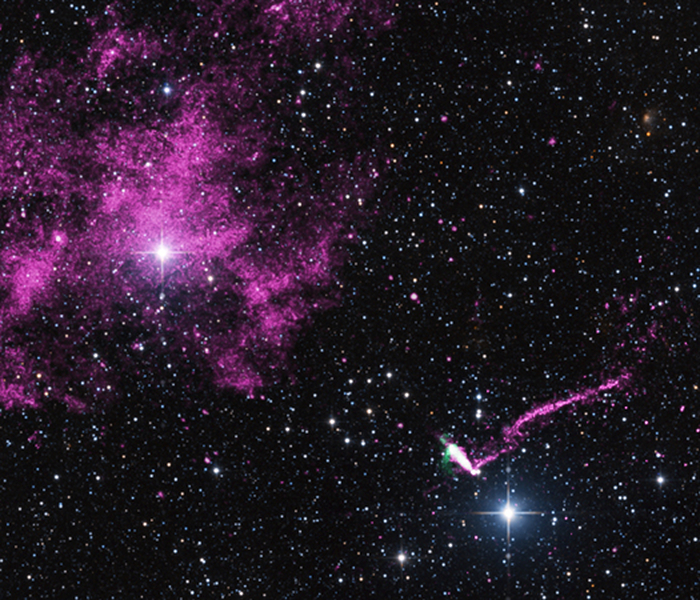
 Credit: NASA/CXC/ISDC/L.Pavan et al., Radio: CSIRO/ATNF/ATCA Optical: 2MASS/UMass/IPAC-Caltech/NASA/NSF
Credit: NASA/CXC/ISDC/L.Pavan et al., Radio: CSIRO/ATNF/ATCA Optical: 2MASS/UMass/IPAC-Caltech/NASA/NSF
Abnormal Supersonic Pulsar Jet
A massive star supernova explosion starts with the sudden collapse of the iron core at the center of the star, crushing it to incredibly high densities. This collapse can produce a fast-spinning, highly magnetized neutron star called a pulsar. Some neutron stars are found near the center of the expanding supernova remnant. The image above, a composite of an X-ray observation (from the Chandra X-ray Observatory), a radio image (from the Australian Telescope National Facility) and an optical image (from the Two Micron All Sky Survey) is an especially interesting example of a runaway pulsar, one which has left its parent remnant, never to return. The pulsar, IGR J11014-6103, is moving supersonically away from its supernova remnant (called SNR MSH 11-61A, seen as the diffuse, glowing hot gas in the upper left of the image) at an incredible speed of 2.5 to 5 million miles per hour. A short, glowing pulsar wind nebula of charged particles trails behind the pulsar like the tail of a comet. The pulsar also emits an unusually long particle-beam jet along its spin axis. This jet extends out over 30 light-years in extent, making it the longest jet ever detected in the Milky Way. IGR J11014-6103 presents two puzzles for astronomers: why is the jet perpendicular to the direction of motion, and what caused the pulsar to be shot out from the center of the supernova explosion?
Published: March 10, 2014
<
HEA Dictionary ● Archive
● Search HEAPOW
● Other Languages
● HEAPOW on Facebook
● Download all Images
● Education ● HEAD
>

Each week the HEASARC
brings you new, exciting and beautiful images from X-ray and Gamma ray
astronomy. Check back each week and be sure to check out the HEAPOW archive!
Page Author: Dr. Michael F. Corcoran
Last modified Monday, 26-Feb-2024 17:23:18 EST


